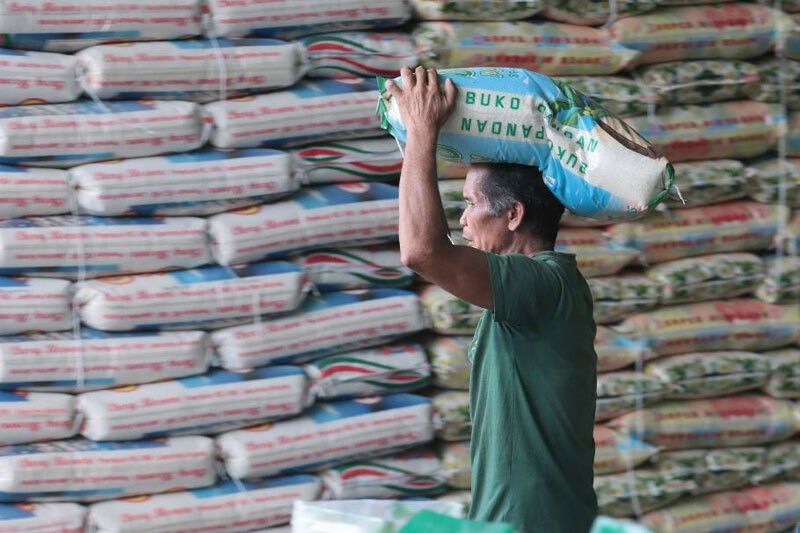Economic team shocked by rice price cap – Diokno

‘We were not consulted’
MANILA, Philippines — Finance Secretary Benjamin Diokno has admitted that the economic team was not consulted when Malacañang imposed a price cap on rice, as he noted that the measure should not last long as it cannot be sustained.
In a briefing, Diokno, who heads the economic team of the Marcos administration, said he was “shocked” when the measure was announced on Aug. 31.
Diokno, along with Socioeconomic Planning Secretary Arsenio Balisacan and Budget Secretary Amenah Pangandaman, led the 14th Philippines-Japan High-Level Joint Committee Meeting on Infrastructure Development and Economic Cooperation in Tokyo during the last week of August.
“We were in Japan when that was announced. I was sitting with Arsi (Balisacan) and we were talking to Japanese investors,” he said. “Of course, we were shocked.”
As rice prices continue to pick up, President Marcos issued an executive order (EO) setting the price ceiling of regular milled rice at P41 per kilo and P45 a kilo for well-milled rice.
The EO was approved based on the joint recommendation of the Department of Agriculture (DA) and the Department of Trade and Industry and had no mention of any of the economic team members.
“Because under ideal market conditions, price controls don’t really work,” Diokno said.
The DOF also could not say how much impact the price control would have on inflation since the economic team was not consulted.
Diokno said the price cap could be in place only for more or less a month as prolonging the measure could not be sustained.
“It has adverse effects if allowed to linger for a longer period,” Diokno said.
The finance chief maintained that the right time to lift the price control is when the conditions for its imposition no longer exist, such as the upcoming rice harvest season and the expected arrival of rice imports.
Further, Diokno argued that there is a need to curb non-competitive behavior in the rice industry by aggressively pursuing cases of hoarding, smuggling and economic sabotage.
He also called for the strict monitoring of the prices of imported rice in the logistics chain and encouraged the public, including retailers, to report individuals violating price caps on rice.
To help guide policy decisions, Diokno said it is important to have timely, granular and accurate information on the status of the rice industry.
“The government must also devote more resources in satellite-based technology and data analytics to complement the dashboard,” he said.
Last week, Malacañang fired Cielo Magno as finance undersecretary after she criticized the price caps.
Rice price stabilization seen in October
The government sees the price of rice stabilizing as thousands of farmers nationwide began harvesting their main season crop this month until October.
Agriculture Undersecretary for rice industry development Leo Sebastian said initial palay harvest is expected to reach two million metric tons by the end of September, and up to three MMT in October.
The estimates were made by the Philippine Rice Information System (PRiSM) as of Aug. 14 using satellite data.
“In all, for the second semester, or July to December, we estimate to produce more than 11 million metric tons and – barring strong typhoons in the remaining months of the year – we hope to hit the 20-MMT level for 2023 national palay output,” Sebastian said in his report to Marcos, who is also the DA secretary.
For September, Sebastian said PRiSM has reported that the bulk of the 2.3-MMT harvest would come from the provinces of Isabela, Cagayan, Iloilo, Nueva Ecija, North Cotabato, Leyte, Oriental Mindoro, Camarines Sur, Palawan, Bukidnon, Zamboanga del Sur and Davao del Norte.
By end of October, most of the estimated 2.9-MMT palay yield would come from Nueva Ecija, Pangasinan, Tarlac, Isabela, Occidental Mindoro, Cagayan, Oriental Mindoro, Bulacan, Iloilo, Bukidnon, Agusan del Sur, Ilocos Sur, Leyte and Camarines Sur.
Sebastian said the DA, under the Masagana Rice Industry Development Program, would continue to provide rice farmers with needed high-yielding seeds, fertilizers, biofertilizers, soil ameliorants, farm machinery, and extension, financial and marketing support.
“Initially, we will focus on fully irrigated clustered farms to optimize palay yield, where farmers would plant high-yielding hybrid rice varieties, to at least one million hectares and we expect them to produce an average of six to eight MT per hectare, for a total of six to eight MMT,” he said.
The government started on Saturday the distribution of P15,000 cash aid to each small retailer of rice affected by the newly imposed cap on rice prices.
Carinderias raise rice prices
Carinderia owners increased the price of rice per cup by P3 – P15 from the previous P12 – amid the spike in the retail prices of the staple food.
In a radio interview, Philippine Association of Stores and Carinderia Owners Inc. vice president Joan Hipolito said that eateries are not buying the P41 and P45 kilo of rice being sold under EO 39, saying that customers prefer grains of good quality.
“Filipinos patronize good quality rice, so that when mixed with sauces, they are encouraged to eat more,” Hipolito said.
Hipolito added that other eatery owners who opt not to increase their prices implement alternatives by decreasing the serving of rice.
“Eateries usually serve value meals at P75 per kilo, which include rice and one dish. We explain to our customers why we need to lessen the serving of rice,” Hipolito added.
According to Hipolito, aside from high prices of rice, the carinderia owners are also affected by the upward trend in the retail cost of vegetables.
“Tomatoes are now sold at P240 per kilo and a bundle of leafy vegetables also increased to P15 from P10,” she noted.
She said despite the high cost of food, eateries have no choice but to continue their operation.
“They cannot afford to stop operations as they have no other source of income. They just need to adjust to the spike of prices of basic commodities,” Hipolito said.
Meanwhile, Hipolito said that many sari-sari owners also decided to stop selling rice.
“Many of our member sari-sari store owners said that they will stop selling rice as they can no longer afford the high cost,” Hipolito said.
Philippine Rice Industry Stakeholders Movement co-founder and Grains Retailers’ Confederation of the Philippines, Inc. national spokesperson Orly Manuntag said that a retailer loses P500 per sack of rice sold at P45 per kilo or P7,000 a day, and at least P49,000 in just one week of the implementation of the price cap.
Eerily similar to 2018 crisis
Farmers’ group Federation of Free Farmers (FFF) national manager Raul Montemayor on Sunday said that the present rice crisis is “eerily similar” to the one in 2018.
As in the 2018 crisis, the rice stocks of the National Food Authority (NFA) were depleted, Montemayor told The STAR.
“In 2018, there was a crisis after the NFA was not allowed to import until the end. Today, it is the private sector who does not want to import, while the NFA was prohibited to import under the Rice Tariffication Law,” he continued.
“In 2018, the country underwent a rice crisis. By October, retail prices of well-milled rice reached almost P50 per kilo, up 14 percent over prices in the previous year. Prices for regular-milled rice rose by 16 percent. This coincided with the depletion of NFA stocks, delays in import arrivals, and a dip in local production. It was only when then President Duterte ordered NFA to immediately import and allow private traders to bring in rice did rice prices stabilize,” Montemayor said.
According to him, the current situation is strangely similar where the NFA stocks are down to just one day’s national consumption.
“Entering the three-month lean period in July 2023, over-all inventories held by farm households, private traders and NFA, sufficed for only about 60 days. Rice from abroad was supposed to cover the 30-day gap, but the war in Ukraine, climatic disturbances and the Indian export ban rendered rice importation expensive and risky. As stocks began thinning out in August and September, prices ascended to levels beyond those in 2018,” Montemayor added.
He said the 2018 rice crisis triggered the rapid passage of the Rice Tariffication Law (RTL) or Republic Act 11203 in February 2019.
“Blaming government import controls, RTL’s proponents argued that the private sector could manage the rice market more efficiently. As a result, NFA’s importation, regulatory and price stabilization functions were abolished. The agency was relegated to buffer stocking for calamities. The private sector was given free and unlimited rein over rice importations,” Montemayor noted.
He said imports immediately surged to 3.17 million tons in 2019, from previous annual levels of two million tons or less.
Montemayor said that the country’s self-sufficiency ratio, or the percentage of total food and other requirements produced by farmers, decreased from 90 percent prior to RTL to 79 percent in 2021.
“We became increasingly dependent on foreign suppliers. Rice imports accounted for an average of 19 percent of our total annual supply during the RTL period, compared to only 14 percent before that,” Montemayor noted.
He warned that if El Niño persists until next year and international prices remain high, “we could end up in an even worse predicament, come the lean months of 2024.”
“There is still some time to prepare for this contingency.
We should provide our farmers with the right price incentive in the coming harvest season, so that they will scale up production during the next production cycle.
We should put in place the necessary post-harvest facilities to reduce losses and enhance the quality and market value of their produce,” he said. — Helen Flores, Bella Cariaso, Ramon Efren Lazaro
- Latest
- Trending


























